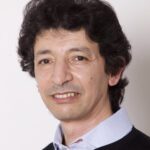Link to Pubmed [PMID] – 23045546
Link to DOI – 10.1083/jcb.201202012
J Cell Biol 2012 Oct; 199(2): 381-99
The mechanisms underlying retinal dystrophy in Usher syndrome type I (USH1) remain unknown because mutant mice lacking any of the USH1 proteins-myosin VIIa, harmonin, cadherin-23, protocadherin-15, sans-do not display retinal degeneration. We found here that, in macaque photoreceptor cells, all USH1 proteins colocalized at membrane interfaces (i) between the inner and outer segments in rods and (ii) between the microvillus-like calyceal processes and the outer segment basolateral region in rods and cones. This pattern, conserved in humans and frogs, was mediated by the formation of an USH1 protein network, which was associated with the calyceal processes from the early embryonic stages of outer segment growth onwards. By contrast, mouse photoreceptors lacked calyceal processes and had no USH1 proteins at the inner-outer segment interface. We suggest that USH1 proteins form an adhesion belt around the basolateral region of the photoreceptor outer segment in humans, and that defects in this structure cause the retinal degeneration in USH1 patients.

